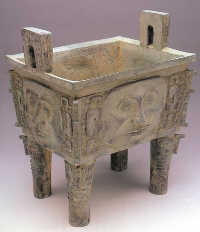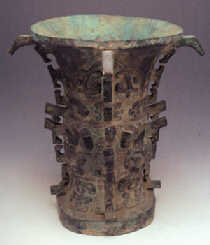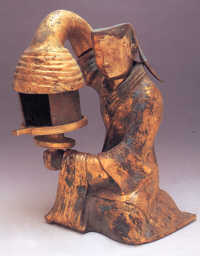 Set in a fiercely blazing fire, the beast's bulging eyes glare straight at the observer; his great mouth forms a wide grin, flashing saber-like teeth. His stiletto claws are exposed and poised for action, and a pair of ears or horns protrudes from his head. As ferocious of a sight as this may be, the image conveys both mystery and beauty.
Set in a fiercely blazing fire, the beast's bulging eyes glare straight at the observer; his great mouth forms a wide grin, flashing saber-like teeth. His stiletto claws are exposed and poised for action, and a pair of ears or horns protrudes from his head. As ferocious of a sight as this may be, the image conveys both mystery and beauty.
The symbolic design, known as the "tao-tie" or "beast of gluttony", was used on Chinese sacrificial bronze 3,000 years ago, combining all sorts of animal characteristics found in the natural world into one ferocious creature. The tao-tie is one of the most fantastic and imaginative designs found among Chinese bronze designs. It uniquely communicates the religious and ritual spirit of ancient Chinese bronze vessels.
Bronze is an alloy of copper, tin and a small amount of lead. Its appearance marked the advancement of human culture from the Stone Age to the Bronze Age. From the 17th century BC to the Han Dynasty (206BC-AD200), Chinese people used rare and precious bronze to cast large quantities of ritual vessels, musical instruments and weapons that were elegant in form, finely decorated and clearly inscribed with Chinese characters. They affirm the artistic achievements of ancient China, and demonstrate how early Chinese used their ingenuity to create works that incorporated both science and art from natural resources.
In the China's ancient ritualistic society, bronze was used primarily for casting ceremonial temple vessels used in sacrifices to the gods of heaven, earth, the mountains and rivers. They were also used in vessels for banquets, awarding ceremonies and noble funerals. Since bronze is a durable material resistant to cracks and breakage, it was used by kings to cast inscribed vessels honoring the ancestors of dukes, princes and ministers who made great contributions to their nation or sovereign, serving as a reminder to later generations. The world-famous Mao Gong Ding, for example, a bronze tripod on display at the National Palace Museum in Taipei, was imperially commissioned. Inside the tripod is an inscription 497 characters in length, divided into 32 lines and two halves that extend from the mouth of the vessel to the bottom. The inscription is the imperial mandate for the casting of the vessel, written in a stately and powerful tone. The inscription on this particular vessel is the longest among all bronze unearthed so far.
 Bronze can be classified into four main types based on function: food vessels, wine vessels, water vessels and musical instruments. Within each group are endless variations ranging in form and design, fully demonstrating the rich imagination and creativity of the ancient Chinese people. The Gui, for example, was a container for cooked millet that came in many different styles, equivalent to today's containers for cooked rice. Some had a circular base to stabilize the vessel belly; others had a heavy square base added to the circular base, forming a graceful contrast in geometric forms. The Ding was a tripod vessel used for cooking, with a pair of knobs protruding from the mouth to facilitate handling. The three legs held the vessel at a proper distance from the fire for cooking meat. The Jue was a vessel especially designed for heating and drinking wine; it had a spout and side handles. The three legs facilitated the warming of the wine. The Zun was a major type of wine container that was either round or square in shape, or had a round mouth and square base. Ancient Chinese bronze stressed balance and symmetry in form, and communicated solemnity and ceremony.
Bronze can be classified into four main types based on function: food vessels, wine vessels, water vessels and musical instruments. Within each group are endless variations ranging in form and design, fully demonstrating the rich imagination and creativity of the ancient Chinese people. The Gui, for example, was a container for cooked millet that came in many different styles, equivalent to today's containers for cooked rice. Some had a circular base to stabilize the vessel belly; others had a heavy square base added to the circular base, forming a graceful contrast in geometric forms. The Ding was a tripod vessel used for cooking, with a pair of knobs protruding from the mouth to facilitate handling. The three legs held the vessel at a proper distance from the fire for cooking meat. The Jue was a vessel especially designed for heating and drinking wine; it had a spout and side handles. The three legs facilitated the warming of the wine. The Zun was a major type of wine container that was either round or square in shape, or had a round mouth and square base. Ancient Chinese bronze stressed balance and symmetry in form, and communicated solemnity and ceremony.
Most line designs used on bronze combine a main motif with a border design, emphasizing its three-dimensional character. The "beast of gluttony" design was the most prominent in Shang Dynasty (16th-11th century BC) vessels. A profile of two separate symmetrical beasts was embossed on the vessel, which, when viewed from the front, combined their features into one bestial form. After the Western Zhou period (11th century to 771BC), bird designs gradually became popularized as the main decorative designs, still maintaining the principle of symmetry. After the mid and late Western Zhou period, chain-link patterns, fish-scale patterns and wave patterns superseded animals as the main subject matter for bronze vessels. The principle of symmetry began to break up at this point and was substituted by recurring chain links or band designs that encircled the vessel's body. After the mid Spring and Autumn period (770-476BC), the most frequently used design was a vertical interlocking geometrical animal band design. In the Shang Dynasty, the border design used to complement the main design included clouds and lightning. Beginning in the mid-Western Zhou, the designs became increasingly sparse, and border designs eventually became obsolete. After the Spring and Autumn period, the "sprouting grain" and other designs began appearing in borders.
The techniques used in executing various bronze designs went from engraved lines and embossed designs used in earlier periods to deep reliefs and three-dimensional sculpture-like designs, and, eventually, even to inlaid designs. Materials used for inlays included gold, silver, copper and turquoise. Subject matter for inlaid work included animals, along with interlocking geometrical shapes based on straight lines, diagonal lines and whorled lines. These were added purely for decorative purposes, and were intricately and handsomely crafted.
 Over the millennia, bronze articles exposed to high humidity or buried underground underwent a natural process where they developed a bright and beautiful coating, or patina, which served as a protective coating. The color itself, however, which ranges from rouge red to emerald green to sapphire blue, imparts added beauty and elegance to the vessel. The Chinese are particularly fond of this colorful coating and struggle to preserve it.
Over the millennia, bronze articles exposed to high humidity or buried underground underwent a natural process where they developed a bright and beautiful coating, or patina, which served as a protective coating. The color itself, however, which ranges from rouge red to emerald green to sapphire blue, imparts added beauty and elegance to the vessel. The Chinese are particularly fond of this colorful coating and struggle to preserve it.
In today's People's Republic of China, the beauty of traditional bronze art can still be found in incense burners and sacrificial vessels in temples, in statues on display in schools, or in decorative pieces in homes -- all of which have been influenced by the art of China's ancient bronze. Free application of traditional bronze designs has become an indispensable element of modern architecture, apparel and furniture design. This is one way that the brilliance and artistry of the early Chinese continue to permeate the lives of Chinese today.
